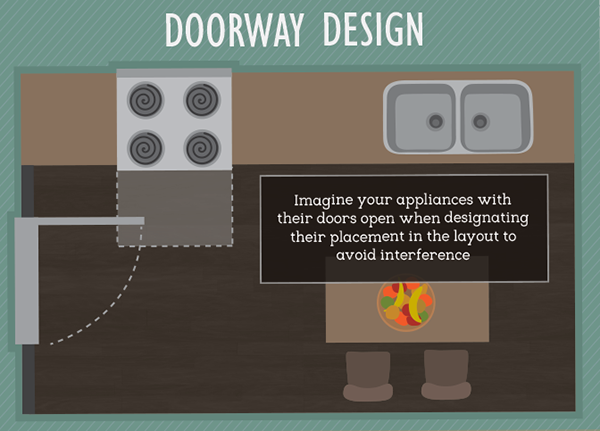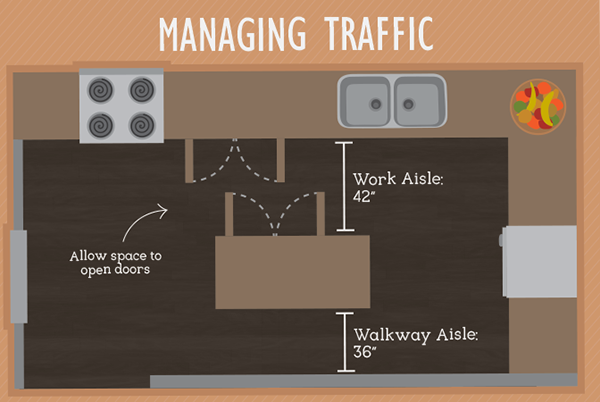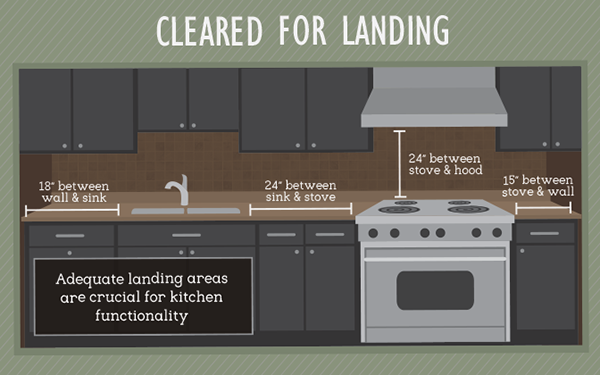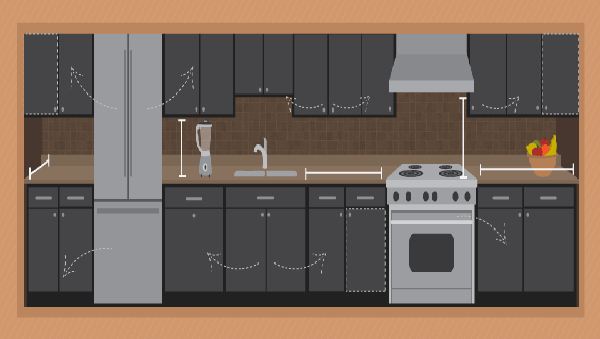By Lee Wallender
Contributing Writer
 Building code and design practices are mean, illogical, and an obstacle to creativity. Right?
Building code and design practices are mean, illogical, and an obstacle to creativity. Right?
Not so fast. Most building code is geared toward safety and is perfectly logical. In one classic example of space-related code, stair balusters must be placed close enough that a four-inch-diameter ball cannot pass through. It’s not an arbitrary number – this width was derived from the size of an average infant’s head. Four inches is considered too narrow for most children to stick their heads through.
By the same logic, code and design practices relating to kitchen space are derived from, and are a solution to, real-world problems. And no space has more potential design problems than the kitchen.
Code Versus Practices
With gas lines, 220V electric service, vent hoods, supply water lines, and sewer pipes – all crammed into a space often no more than 200 square feet – kitchens are complicated and potentially dangerous places. That is why so much code is devoted to this one room.
Because codes are developed by an independent body, the International Code Council, and are adopted into local laws, your kitchen must be up to code whenever you build or remodel.1 To build legally, you must have a permit, which often obligates you to have an inspector determine whether you’ve followed code at the end of your work.
Best design practices are different. These are widely accepted ideas developed by kitchen professionals over time. Sometimes, practices are derived from code. Most often, they are not related to code but are considered common sense.
The classic kitchen triangle, detailed below, is one good example of a design practice that stands on its own. No one ever lost a permit or went to jail because their kitchen did not implement this triangle. It is just a sensible way to plan an efficient kitchen.
Entry Points: Openings and Doors
With the influence of Frank Lloyd Wright’s architecture, the open floor plan came into fashion in the 1940s and has remained fashionable for decades.2 When interior walls came down, kitchen, living room, and dining room became one big space. The cook no longer labored in the kitchen behind closed doors.
But some kitchens still employ doors; and even if no door is used, there will always be an entrance.
Entries: Minimum width for doorway entries is 32 inches.
Doors: If doors are installed, they should not interfere with kitchen appliances, or vice-versa. A lack of clearance can cause damage to both appliance partsand doors, as well as making them inconvenient to use.
 The Kitchen Triangle: Managing Workflow
The Kitchen Triangle: Managing Workflow
The three major work areas of the kitchen are the cooking space (stove and oven), sink, and refrigerator. The kitchen triangle is formed from these three points, and the points should not exceed a maximum distance from each other.3
Because cooks constantly move between these three points, sometimes with hot pots full of liquid, the reasoning is that these paths should remain unimpeded and the points not be too far apart.
- Distance between Points: All three legs of the triangle should not total more than 26 feet.
- Length of Legs: Legs should be between four and nine feet to prevent a grossly imbalanced triangle. Providing length limits means the triangle looks like an actual triangle.
- Impeding the Triangle: Distances between points of the triangle should be straight and unimpeded by tall items like refrigerators or pantry cabinets. It is interesting to note that shorter impediments are allowed, but can invade the triangle by no more than 12 inches. A kitchen island, because it is short, can intersect a leg of the triangle. However, if more than 12 inches of the island are in the triangle, it is considered an impediment.
 Any additional work area – prep sink, microwave, etc. – should be between four and nine feet from the closest point of the kitchen triangle.
Any additional work area – prep sink, microwave, etc. – should be between four and nine feet from the closest point of the kitchen triangle.
Work and Walkway Aisles: Do Not Block Traffic
Designers distinguish between work and walkway aisles. Work aisles are used by cooks or helpers to access any part of the kitchen for cooking purposes. Walkway aisles are used to pass from one part of the house to another via the kitchen, and have nothing to do with cooking.
Work Aisles: Minimum width recommended is 42 inches for a single-cook kitchen, which describes most kitchens. A multiple-cook kitchen should have aisles of 48 inches, minimum.
Walkway Aisles: No walkway routes should pass through the kitchen triangle. Minimum width recommended is 36 inches.
 Countertops: More is Better
Countertops: More is Better
If you ask homeowners what they want most in their remodeled kitchen, a majority will likely say “More countertop space!” Building code rarely deals with counters, but design principles have a lot to say on the matter. Pay attention to these principles now, so you will not be a regretful homeowner down the road.
Total Length of Counters
A minimum of 158 inches, or just over 13 feet, is the recommended minimum linear countertop frontage. This is a best-case scenario, with the understanding that homeowners with small galley or L-shaped kitchens may not be able to install this much countertop space.
Countertop Edges
Rounded or clipped edges are preferred over sharp, 90-degree angle edges. Few countertop companies even manufacture 90-degree edged counters anymore, as this fashion went out with the metal edge-banded Formica countertops of the early 1970s.
This isn’t just to prevent bruises: countertop fabricator and writer Jim Heaphy tells Kitchen and Bath Design News, “Sharp square corners and edges can lead to a variety of long-term problems… I’ve written several times about how square inside corners in appliance cutouts can lead to an increased risk of countertop cracking, especially with relatively brittle, homogeneous products such as solid surface materials.”4
Counter Depth
Counters should be 24 to 25 inches deep (that is, the distance from the edge of the counter to the wall or backsplash). It is difficult to diverge from this number, since nearly all counters are manufactured to this specification.
Space Above Counters
With the advent of larger countertop appliances such as blenders, bread machines, and microwaves, greater space is needed above counters. Thus, allow vertical space of a minimum of 15 inches between countertops and the undersides of wall cabinets.
 Sinks: Placement and Landing Spaces
Sinks: Placement and Landing Spaces
Neither code nor design practices dictate anything about the sink itself. Any practical size is allowed. Sinks can be single-, double-, or even triple-basin. Sink features such as drainage slope, placement of holes for fixtures, and composition of materials are tightly regulated by the manufacturers to adhere to code, so there is little the homeowner can do about this.
Most design practices deal with placement of the sink and areas adjacent to it.
- Placement: Install the sink “adjacent to or across from the cooking surface and refrigerator,” according to National Kitchen and Bath Association (NKBA) Guidelines.
- Counter Landing Areas: It is important that the sink have open countertop spaces called “landing areas” so cooks will have suitable places to rest food items or cookware. The sink should have a minimum of 24 inches of landing area on one side, and a minimum of 18 inches of landing area on the other side.
- Countertop Prep Area: In addition to landing area minimums, it is highly recommended that at least a continuous 36 inches of countertop be located directly next to the sink.
Stoves and Ovens: Critical Zone for Landing Areas
When it comes to countertop spacing, issues concerning stoves and ovens require the most attention. Because heat, gas, electricity, flames, and sometimes noxious fumes are involved, this area touches on safety issues of the highest importance.
Landing Areas
Of all the things that can go wrong with stoves, the most prevalent problem has to do with the “inventive” places cooks find to place hot pans. A minimum of 12 inches of landing space on one side of the stove, and another 15 inches on the other side, are the required landing area widths. As this is hardly enough room to set a single pot or pan, this should be considered an absolute bare minimum, with greater widths highly recommended.
Ovens must have a minimum of 15 inches of adjacent landing area on either side. However, because most ovens tend to be located under stoves as part of a single appliance, this landing area is usually already covered under the stove requirements.
Vertical Space
A total of 24 inches of vertical space is required between the stove and a noncombustible surface such as a vent hood. Vents are not required but are advised, with minimum draw of 150 cubic feet per minute draw.
 If the upper surface is combustible (for instance, cabinets), add yet another six inches of required vertical space, for a total of 30 inches of clearance between stove and cabinets.
If the upper surface is combustible (for instance, cabinets), add yet another six inches of required vertical space, for a total of 30 inches of clearance between stove and cabinets.
Code limits are broad; they do not micro-manage your creativity. Rather, they work in concert to provide the kitchen planner – whether a professional or a do-it-yourselfer – with the freedom to design within broad ranges that protect safety and health, as well as ensuring an efficient kitchen.
Lee Wallender began remodeling homes when he transformed a World War I-era farmhouse into a comfortable new home. He has been writing about home remodeling on About Home Renovations since 2006.
 Pride News Canada's Leader In African Canadian & Caribbean News, Views & Lifestyle
Pride News Canada's Leader In African Canadian & Caribbean News, Views & Lifestyle





